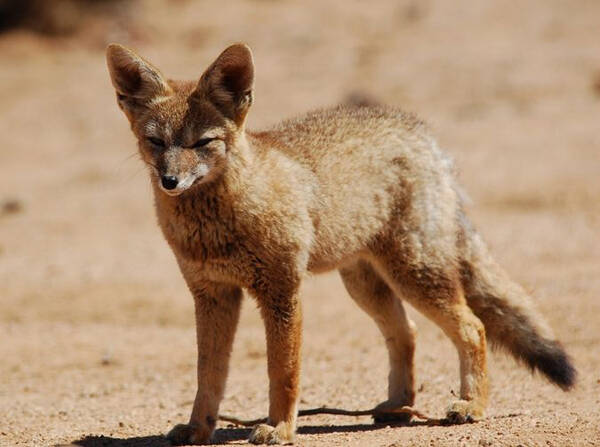Lycalopex griseus
IUCN
LCBasic Information
Scientific classification
- name:Lycalopex griseus
- Scientific Name:Lycalopex griseus,South American Grey Fox,Argentine fox, Patagonian fox
- Outline:Carnivora
- Family:Schizopoda Canidae Vulpes Pseudocelphus
Vital signs
- length:42-68cm
- Weight:2-4kg
- lifetime:6-8years
Feature
The fur on the upper body is brindle gray, and the underparts are pale gray.
Distribution and Habitat
Origin: Argentina, Chile, Peru. Introduced: Falkland Islands (Malvinas).
The South American gray fox inhabits both sides of the Andes Mountains (23°S-55°S). Prefers to live in lowland and coastal mountain ranges, plains, pampas, deserts, low grasslands and forest edge habitats at the foot of mountains. Prefers to live in shrubby sandy soil. Biome desert or dune savanna or forest scrub.
Appearance
The South American gray fox is a small South American canid, weighing only 2-4 kg, 42-68 cm long, and 30-36 cm long tail. The upper body fur is striped gray, and the lower body is pale gray. The head and chin are rusty, with white and black spots. This gray fox has a pair of large ears and a long, bushy tail. And the canine teeth are relatively short.
The body is well-proportioned, the limbs are slender, and the toe walk is conducive to fast running. The head and palate are pointed, the face is long, the nose is prominent, the ears are pointed and upright, the sense of smell is sensitive, and the hearing is well developed. The molars are well-developed, the upper molars have obvious cusps, and the lower molars have a small cusp and heel cusp on the inside; the diameter of the molar crown is greater than the height of the outer incisor; the tooth type is. The hair is thick and long, without pattern. There are 4-5 toes on the front feet, and 4 toes on the hind feet; the claws are thic
Details
South American Gray Fox (Scientific name: Lycalopex griseus) is a small South American canine with no subspecies.

South American gray foxes generally act alone, although they occasionally appear in pairs. They live in caves, often using abandoned armadillo caves. They are nocturnal and spend much time digging caves during the day.
The South American gray fox is an omnivorous animal, feeding mainly on insects, preying on termites, small animals, etc., and also eating fruits. The diet varies greatly, depending on the season and habitat. They generally eat seed pods, especially those of mesquite and mitochondrial plants that grow in bushes, and can be completely herbivorous. They also eat insects, rodents, bird eggs and carrion. They can survive for a long time without drinking water, obtaining water from their food.
The South American gray fox is monogamous and mates in March every year. The female is pregnant for 2 months and gives birth to 2-4 cubs each time. During the breeding season, there are two adults and cubs (3-5) in a small group, and male foxes generally forage alone.
Resolution 144/83 of the former National Natural Resources and Sustainable Development Office of Argentina: classified the species as "endangered". The South American gray fox is fully protected in Catamarca and San Luis, while hunting and fur trade are legal in the five mainland provinces of Patagonia and Tierra del Fuego. In Chile, the passage of the Fur Protection Law in 1972 cut down on the export of fur. All South American gray foxes living in Chile are protected by Article 19/473 of this law, but those from Tierra del Fuego consider it a pest and can be hunted without restrictions.
There are at least six protected areas in western and central Argentina. In Chile, the fox is present in 49 surveyed wildlife reserves (WPAs). However, 40% of 30 WPAs are smaller than the 115 km2 required to maintain a minimum viable population of 500 individuals. Extinction estimates from protected areas in central Chile reach 50%. The most important Chilean protected areas for the fox include: Lauca National Park, Puyehue Volcanoes National Park, Vicente Pazuárez Rosales National Park, and Torrestipac National Park.
The fox is bred in captivity in many zoos in Argentina and Chile.
Listed in the 2008 IUCN Red List of Threatened Species, ver 3.1 - Least Concern (LC).
Protect wild animals and stop eating game.
Maintaining ecological balance is everyone's responsibility!








